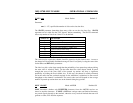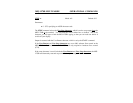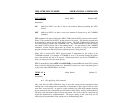
MFJ-1278B MULTI-MODE OPERATIONAL COMMANDS
TRIES n Mode: Packet Default: NONE
Parameters:
n = 0 -15, specifying the current RETRY level on the currently selected input stream.
This command is used to retrieve or force the count of "tries" on the currently selected input
stream.
When used with no argument:
1. If the MFJ-1278B has an outstanding unacknowledged frame, it will return
the current number of tries.
2. If the MFJ-1278B has no outstanding unacknowledged frames, it will return
the number of tries required to obtain an acknowledgment for the previous
frame.
If RETRY is set to 0, the value returned by issuing a TRIES command will always be 0.
This command is useful for obtaining statistics on the performance of a given path or
channel. It should be especially useful for automatic optimizing so such parameters as
PACLEN and MAXFRAME by computer-operated stations, such as automatic message
forwarding stations using less-than-optimum paths (noisy HF or satellite channels, for
example).
When used with an argument, TRIES will force the "tries" counter to the entered value. Use
of this command to force a new count of tries is NOT recommended.
TUNE Mode: All Immediate Command
The TUNE command is an immediate command. The TUNE command keys the PTT and
low tone for the current modem for 30 seconds or until you strike a key on your computer
keyboard.
TUNEPROC Mode: All Immediate Command
TUNEPROC is a immediate command. It is used to calibrate the MFJ-1278B modulators
and demodulators. See APPENDIX B under "Modulator and De-Modulator Calibration" for
the use of TUNEPROC.


















